p.304
p.309
p.313
p.319
p.323
p.331
p.338
p.344
p.348
A Mathematical Model Forecasting HF Adsorption onto Cu-Coated Wafers as a Function of the Airborne Concentration and Moisture
Abstract:
In order to better understand and model the whole sorption behavior of the HF when in contact with a Cu surface inside a FOUP and thus control the related yield losses, Cu-coated wafers have been exposed to varying HF (ppbv) and H2O (% RH) airborne concentrations. These experiments have yielded a HF-Cu sorption empirical-mathematical model that may be used as an industrial tool for queue-time or fluoride surface concentration predictions. Besides, the formation of CuF2 only in case of corrosion is evidenced by the XPS measurements whereas the key role of the H2O is further confirmed by the desorption experiments. The H2O retained by the surface is actually responsible for promoting the HF adsorption/desorption onto/from Cu and enables a HF threshold concentration that separates the two well differenced uptake regimes; adsorption and corrosion.
Info:
Periodical:
Pages:
323-328
Citation:
Online since:
September 2016
Keywords:
Price:
Сopyright:
© 2016 Trans Tech Publications Ltd. All Rights Reserved
Share:
Citation:


